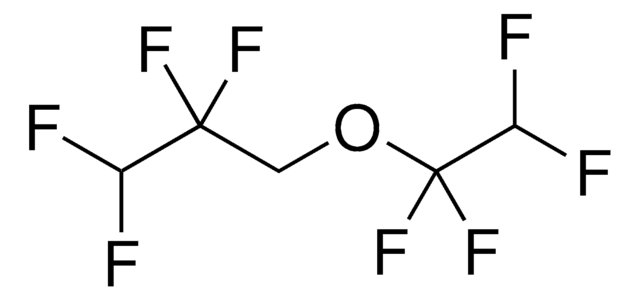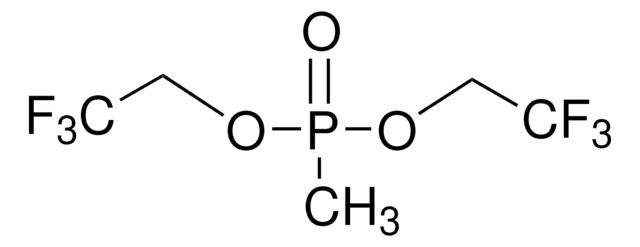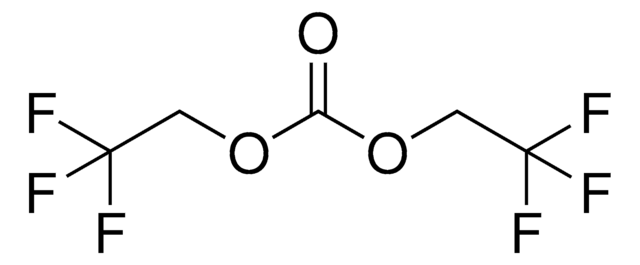287571
Bis(2,2,2-trifluoroethyl) ether
98%
Synonym(s):
2,2,2-Trifluoroethyl ether, Flurothyl
Sign Into View Organizational & Contract Pricing
All Photos(1)
About This Item
Linear Formula:
(CF3CH2)2O
CAS Number:
Molecular Weight:
182.06
Beilstein:
1811927
MDL number:
UNSPSC Code:
12352100
PubChem Substance ID:
NACRES:
NA.22
Recommended Products
Quality Level
Assay
98%
form
liquid
refractive index
n20/D 1.300 (lit.)
bp
62-63 °C (lit.)
density
1.404 g/mL at 25 °C (lit.)
functional group
ether
fluoro
SMILES string
FC(F)(F)COCC(F)(F)F
InChI
1S/C4H4F6O/c5-3(6,7)1-11-2-4(8,9)10/h1-2H2
InChI key
KGPPDNUWZNWPSI-UHFFFAOYSA-N
Looking for similar products? Visit Product Comparison Guide
Application
Bis(2,2,2-trifluoroethyl) ether was used to diminish self-discharge of Li-S cells having both low- and high-sulfur-loading sulfur cathodes.
accessory
Product No.
Description
Pricing
Signal Word
Danger
Hazard Statements
Precautionary Statements
Hazard Classifications
Eye Irrit. 2 - Flam. Liq. 2 - Skin Irrit. 2 - STOT SE 3
Target Organs
Respiratory system
Storage Class Code
3 - Flammable liquids
WGK
WGK 3
Flash Point(F)
33.8 °F - closed cup
Flash Point(C)
1 °C - closed cup
Personal Protective Equipment
dust mask type N95 (US), Eyeshields, Gloves
Choose from one of the most recent versions:
Already Own This Product?
Find documentation for the products that you have recently purchased in the Document Library.
Customers Also Viewed
Omar I Khan et al.
Neurobiology of disease, 39(3), 362-371 (2010-05-11)
Frequent interictal spikes are a common finding in the electroencephalograms of children with epileptic encephalopathies. While it is well recognized that interictal spikes are a biological marker of seizures and can lead to transitory cognitive impairment, whether interictal spikes can
Havisha B Karnam et al.
Epilepsy research, 85(2-3), 221-230 (2009-04-28)
Clinical studies have suggested that seizures in newborns are more damaging than seizures occurring in older children. However, these studies are difficult to interpret for a variety of factors including differing etiologies of seizures across ages. Animal studies can provide
Megan Leigh Lewis et al.
Epilepsia, 59(7), 1316-1326 (2018-06-03)
In different cohorts, 5%-30% of individuals with autism spectrum disorder (ASD) also have epilepsy. The high co-occurrence of these disorders suggests that a common mechanistic link may exist. The underlying pathophysiology of this comorbidity remains unknown. To investigate the mechanism(s)
Stacey B B Dutton et al.
Epilepsia, 52(11), 2050-2056 (2011-08-02)
We evaluated the ability of the ketogenic diet (KD) to improve thresholds to flurothyl-induced seizures in two mouse lines with Scn1a mutations: one that models Dravet syndrome (DS) and another that models genetic (generalized) epilepsy with febrile seizures plus (GEFS+).
Yogendrasinh H Raol et al.
Annals of neurology, 65(3), 326-336 (2009-04-01)
Neonatal seizures occur frequently, are often refractory to anticonvulsants, and are associated with considerable morbidity and mortality. Genetic and electrophysiological evidence indicates that KCNQ voltage-gated potassium channels are critical regulators of neonatal brain excitability. This study tests the hypothesis that
Our team of scientists has experience in all areas of research including Life Science, Material Science, Chemical Synthesis, Chromatography, Analytical and many others.
Contact Technical Service












